In a groundbreaking move, China’s ADA Space has initiated the launch of an ambitious 2,800-satellite network designed to function as an AI-driven supercomputer in orbit. This is not merely an incremental upgrade in satellite technology; it represents a paradigm shift in how data is processed in space. As the first twelve satellites of the “Three-Body Computing Constellation” make their debut, they usher in an era where data collection and processing can occur in real-time, beyond the limits imposed by terrestrial infrastructures.
Cutting-Edge Processing Power
Each satellite in the initial launch is equipped with an impressive onboard AI model containing 8 billion parameters, capable of delivering a staggering 744 tera operations per second (TOPS). Collectively, these satellites will achieve a processing capacity of 5 peta operations per second (POPS). To put this in perspective, that is exponentially more powerful than what is needed for applications like Microsoft’s Copilot PC. The scale of this technological leap cannot be overstated; these satellites are engineered to redefine the possibility of computational capabilities in space.
Revolutionizing Communication and Data Transfer
One of the remarkable attributes of this satellite constellation is its communication system, which employs a laser-based network capable of transferring data at speeds of up to 100 Gbps. This technological innovation not only accelerates data transfer but also paves the way for better management and utilization of the vast amounts of information being gathered. Traditional satellite systems face substantial limitations, often dealing with slow transmissions and the drawbacks of limited ground station accessibility. With claims that less than 10 percent of satellite data makes it to Earth due to these constraints, it’s clear that ADA Space’s initiative is on the cutting edge of solving these persistent issues.
Applications Across Multiple Fields
The functionality of this satellite network extends far beyond traditional data handling; it will enable sophisticated capabilities such as producing 3D digital twin data that can serve in versatile fields ranging from emergency response systems to gaming and tourism. The value of such technology has immediate implications, particularly in areas needing rapid data analysis and situational awareness. For example, creating accurate real-time 3D models could significantly enhance disaster management efforts, offering critical insights when they are needed most.
Scientific Endeavors and Cosmic Exploration
In addition to its practical applications, the constellation is also designed with scientific exploration in mind. Notably, the first batch of satellites includes sophisticated payloads, including an X-ray polarization detector aimed at capturing fleeting cosmic events, such as gamma-ray bursts. This blend of computational power with scientific inquiry signifies an exciting frontier as researchers seek to understand some of the most enigmatic phenomena in our universe.
China’s strategic push to embrace advanced space technology through ADA Space not only highlights its ambition but also sets a competitive benchmark in the global arena. As nations recognize the transformative potential of space-based AI processing, ADA Space could very well take the lead in shaping the future of technology in ways we are just beginning to imagine.


Leave a Reply